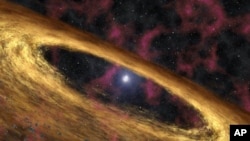NASA, the U.S. space agency, has awarded $3 million in grants for 30 proposals which explore new ideas for America’s next generation space program.
The proposals reflect wide-ranging visions of new spacecraft designs, new propulsion systems and an expanded human presence in space. They each receive a first-year development grant of $100,000 to prove their worth.
NASA’s Innovative Advanced Concepts program (NIAC) received hundreds of proposals representing almost every aspect of the agency's mission.
“Just looking down the list, there are some that are related to humans trying to operate in space, some that are related to spacecraft trying to operate safely or protecting people from radiation," program executive Jay Falker says, "some that are improved propulsion concepts, some that are improved structures and some that would maybe enable us to do the kinds of missions we’ve done before, a space station or a space telescope, but much, much more efficiently.”
The selected proposals came from academia, industry and from within NASA itself.
For example, NASA’s Goddard Space Flight Center wants to build a kind of optical “tweezers” - a laser device that could be used on deep space probes to collect samples of space debris:
“In the proposal they mention, a type that might be on a rover like on Mars and instead of having a physical scoop that goes and gets some rock or soil, there’s a small laser trap that can do that," Falker says. "But they also show one in space. For example, it could fly near a comet and collect some of the materials of that or even, to me most interesting, because we can’t do it at all today, there’s the possibility of trying to do that during planetary entry and descent.”
Another concept, this one from Virginia-based Raytheon BBN Technologies, would use a balloon-lofted, high-altitude air gun to change the course of potentially dangerous orbital junk, such as inoperative satellites.
“The idea is to simply pulse or puff a little bit of the atmosphere up into the way of the orbiting debris," Falker says. "And that pulse of air, if we do it right, would force it to slow down, enter the atmosphere, burn up faster than it would have otherwise and may also enable us to tactically avoid a collision.”
Other proposals include a skin-tight spacesuit with sensors and flywheels to stabilize astronauts in microgravity; a propulsion system that relies on giant sails to catch the solar wind; and the use of 3-D printer technology to construct small spacecraft or components for a planetary outpost.
“The second level of that same kind of thinking is when we get good at this, people will begin to design differently because instead of taking years in development, we can get an idea, get prototypes developed quickly," Falker says. "Then we can begin sending the printers into orbit and to other destinations and that’s where we can imagine entirely different design schemes two or three generations down the road.”
Over the next year the scientists will work on their ideas, even develop and test hardware related to their projects.
According to Falker, the $3-million price tag is a drop in NASA’s proposed $18 billion budget for 2012. He’s confident it can survive any funding cuts.
“Most of the country, Congress is behind the idea that NASA should be exploring some visionary concepts and this small amount of money is worth it, and I know if we get one breakthrough, it will absolutely be worth it.”
A precursor to the NIAC program, which began in 1998, was suspended in 2007 after a cost-conscious U.S. Congress ordered a review of its effectiveness. A year later, a national panel of experts recommended that NASA continue investigating advanced concepts. Congress eventually gave the go-ahead to restore the program this year.
According to Falker, at year’s end, the scientists can compete for additional funds to move their concepts forward, with the hope of eventually integrating them into a future space mission.











